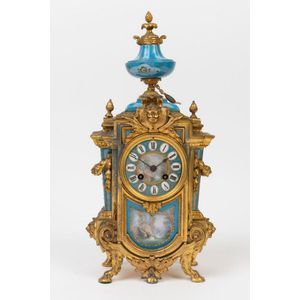A neoclassical Sevres style porcelain mounted ormolu mantel…
A neoclassical Sevres style porcelain mounted ormolu mantel clock, late 19th century, in bleu celeste, with an urn shaped finial, the painted dial with Roman numeral cartouches, on bell strike and the mechanism marked El, with pendulum, 39 cm high, 29 cm wide, 10 cm deep. Provenance: The Estate of Paul Benjamin Phillip Krongold
You must be a subscriber, and be logged in to view price and dealer details.
Subscribe Now to view actual auction price for this item
When you subscribe, you have the option of setting the currency in which to display prices to $Au, $US, $NZ or Stg.
This item has been sold, and the description, image and price are for reference purposes only.
- Ormolu - Ormolu was popular with French craftsmen in the 18th and 19th century for ornamental fittings for furniture, clocks and other decorative items. True ormolu is gilt bronze, that is bronze that has been coated with gold using a mercury amalgam. Due to the health risks associated with using mercury, this method of creating ormolu was discontinued in France in the 1830s. A substitute was developed consisting of about 75% copper and 25% zinc, however it was inferior to the bronze version. It was often lacquered to prevent it tarnishing.
- Pendulum - The pendulum was discovered around 1602 by Galileo Galilei, and was adopted for time keeping by the Dutch mathematician and natural philosopher, Christiaan Huygens, who excelled in astronomy, physics, and horology.
The pendulum comprises a metal rod usually of brass or steel with a metal disk, known as a bob, at the end. The movement of the pendulum is driven by weights or a spring, and as a pendulum swings in a regular arc, it was found accuracy could be controlled to within a few seconds a week.
Timekeeping can be adjusted by changing the height of the bob on the rod, making the pendulum either swing slower or faster.
The disadvantage of the pendulum was that changes in temperature also changed the length of the pendulum, interfering with the accuracy of the clock, and so in the 18th century two types of mercurial pendulums were invented which countered the movement in the steel rod.
The pendulum was the world's most accurate timekeeping technology until the invention of the quartz clock, regulated by a quartz crystal, in 1927. - Bleu Celeste - "Bleu céleste" is a French term that translates to "sky blue" in English, and it refers to a specific shade of blue pigment used in the decoration of porcelain. This color is a light, sky-blue shade that was often used in combination with other colors to create intricate designs on porcelain pieces. The use of "bleu céleste" was was first used by the Sèvres porcelain factory in the 18th century, and became popular in the 19th century. The colour is created by adding copper oxide to the glaze. It was valued for its ability to add a touch of lightness and delicacy to porcelain designs. The color was often used to create floral motifs, landscapes, and other decorative elements, and it was prized for its ability to evoke feelings of calmness and serenity.
- Finial - An architectural decoration, found on the upper parts of of an object. On furniture they are usually found on pediments, canopies and shelf supports. On smaller ceramic or silver items, such as spoons, they may decorate the top of the item itself, or the lid or cover where they provide a useful handle for removal.
Finials have a variety of shapes and forms. They may be urn-shaped, baluster shaped round or spiral, but usually taper into an upper point. Many real life shapes may also be used as finials, such as pineapples, berries, pinecones, buds, lotus and acorns. Sometimes animals such as a lion are depicted, or fish and dolphins.
This item has been included into following indexes:
